How the Italian Residential Sector Could Contribute to Load Flexibility in Demand Response Activities: A Methodology for Residential Clustering and Developing a Flexibility Strategy
Abstract
:1. Introduction
2. Materials and Methods
- electricity consumptions (storable loads, shiftable loads, non shiftable loads);
- electric-driven heating systems and/or Domestic Hot Water (DHW);
- PV array installation;
- dwelling size;
- the occupancy modelling (occupant number, time scheduling).
Database Description and Sample Users
3. Results and Discussions
3.1. Electric Consumption Time Scheduling of Selected Archetypes
3.2. Users Virtual Aggregation
3.3. Electricity Price Trend on the Italian Spot Market
3.4. Loads Time-Shifting Strategy Identification
3.5. Flexibility Indicators Calculation
4. Conclusions
- 14 dwelling archetypes have been defined by the use of a numerical approach based on a grade scale ranging between 0 and 1; each sample household (i.e., 751) has been compared to the archetypes in order to identify its category; this method leads to a good fitting since, on average, the best grade is equal to 0.81;
- the most representative archetypes, in terms of the highest number of dwellings belonging to them, are the #9, #6, and #5 corresponding to 165, 138, and 102 sample households, respectively;
- from data collected by a survey, the available potential of flexibility related to the dwellings cluster has been calculated and it is equal to 538.95 MWh/year; therefore, the average daily value of flexible loads per dwelling is equal to 1966 Wh/d;
- by simulating a flexible strategy on an RC of Italian residential sector, which is based on the hourly pricing mechanism following the day-ahead market outcomes, and on limitations of power uptakes, monthly and annual indicators have been defined; so doing, the flexible strategy effectiveness can be computed to assess its actual suitability;
- the highest monthly effectiveness values have been registered in the cold season over the non-working days ranging between 0.49 and 0.53. Conversely, in the hot season, the maximum effectiveness values are generally lower compared to the winter ones (i.e., 0.3–0.4) and they occur over the weekdays. In the end, all those results can be outlined by means of a single indicator (annual effectiveness), which, in this case, is 0.34.
Author Contributions
Funding
Acknowledgments
Conflicts of Interest
Appendix A
Building location
| Kitchen
|
Appendix B
| Limit | Percentile | PUN [€/MWh] | |||||||||||
|---|---|---|---|---|---|---|---|---|---|---|---|---|---|
| Jan | Feb | Mar | Apr | May | June | Jul | Aug | Sept | Oct | Nov | Dec | ||
| 1 | 75th | 66.4 | 65.9 | 63.3 | 60.0 | 59.1 | 60.1 | 64.2 | 63.2 | 73.9 | 73.7 | 65.7 | 63.8 |
| 2 | 50th | 61.2 | 59.3 | 56.6 | 54.6 | 54.9 | 57.0 | 60.5 | 59.3 | 66.5 | 66.7 | 61.7 | 59.4 |
| 3 | 50th | 61.2 | 59.3 | 56.6 | 54.6 | 54.9 | 57.0 | 60.5 | 59.3 | 66.5 | 66.7 | 61.7 | 59.4 |
| 4 | 25th | 52.6 | 52.6 | 49.3 | 48.4 | 49.8 | 52.0 | 56.4 | 56.1 | 59.5 | 56.4 | 52.0 | 50.4 |
| Limit | Percentile | PUN [€/MWh] | |||||||||||
|---|---|---|---|---|---|---|---|---|---|---|---|---|---|
| Jan | Feb | Mar | Apr | May | June | Jul | Aug | Sept | Oct | Nov | Dec | ||
| 1 | 75th | 63.2 | 59.8 | 54.8 | 53.6 | 55.1 | 52.7 | 58.1 | 58.8 | 62.2 | 65.2 | 57.0 | 55.5 |
| 2 | 50th | 56.0 | 52.9 | 49.8 | 47.8 | 49.4 | 48.7 | 53.5 | 53.8 | 58.4 | 58.3 | 54.1 | 51.9 |
| 3 | 50th | 56.0 | 52.9 | 49.8 | 47.8 | 49.4 | 48.7 | 53.5 | 53.8 | 58.4 | 58.3 | 54.1 | 51.9 |
| 4 | 25th | 52.2 | 48.4 | 45.8 | 44.5 | 45.8 | 43.8 | 49.9 | 51.1 | 55.2 | 54.4 | 51.3 | 47.7 |
| Limit | Percentile | PUN [€/MWh] | |||||||||||
|---|---|---|---|---|---|---|---|---|---|---|---|---|---|
| Jan | Feb | Mar | Apr | May | June | Jul | Aug | Sept | Oct | Nov | Dec | ||
| 1 | 75th | 55.9 | 51.7 | 52.0 | 49.1 | 49.5 | 50.0 | 53.1 | 56.2 | 56.7 | 54.8 | 52.7 | 52.5 |
| 2 | 50th | 51.8 | 47.0 | 47.5 | 43.9 | 42.9 | 43.1 | 45.6 | 51.4 | 54.0 | 51.8 | 49.9 | 46.9 |
| 3 | 50th | 51.8 | 47.0 | 47.5 | 43.9 | 42.9 | 43.1 | 45.6 | 51.4 | 54.0 | 51.8 | 49.9 | 46.9 |
| 4 | 25th | 48.7 | 43.4 | 44.4 | 38.4 | 39.5 | 39.4 | 42.3 | 47.7 | 52.3 | 49.4 | 45.3 | 43.3 |
| Limit | Percentile | POWER [W] | |||||||||||
|---|---|---|---|---|---|---|---|---|---|---|---|---|---|
| Jan | Feb | Mar | Apr | May | June | Jul | Aug | Sept | Oct | Nov | Dec | ||
| 1 | 75th | 268 | 309 | 266 | 271 | 243 | 286 | 294 | 320 | 265 | 272 | 305 | 327 |
| 2 | 50th | 219 | 252 | 212 | 245 | 219 | 220 | 202 | 254 | 216 | 228 | 248 | 259 |
| 3 | 50th | 219 | 252 | 212 | 245 | 219 | 220 | 202 | 254 | 216 | 228 | 248 | 259 |
| 4 | 25th | 175 | 223 | 190 | 213 | 191 | 204 | 169 | 206 | 201 | 212 | 228 | 239 |
| Limit | Percentile | POWER [W] | |||||||||||
|---|---|---|---|---|---|---|---|---|---|---|---|---|---|
| Jan | Feb | Mar | Apr | May | June | Jul | Aug | Sept | Oct | Nov | Dec | ||
| 1 | 75th | 333 | 393 | 391 | 338 | 287 | 297 | 260 | 269 | 309 | 272 | 337 | 395 |
| 2 | 50th | 269 | 323 | 297 | 253 | 265 | 248 | 197 | 229 | 282 | 249 | 276 | 310 |
| 3 | 50th | 269 | 323 | 297 | 253 | 265 | 248 | 197 | 229 | 282 | 249 | 276 | 310 |
| 4 | 25th | 133 | 186 | 212 | 167 | 180 | 198 | 171 | 187 | 173 | 201 | 231 | 222 |
| Limit | Percentile | POWER [W] | |||||||||||
|---|---|---|---|---|---|---|---|---|---|---|---|---|---|
| Jan | Feb | Mar | Apr | May | June | Jul | Aug | Sept | Oct | Nov | Dec | ||
| 1 | 75th | 348 | 391 | 354 | 349 | 290 | 322 | 245 | 278 | 345 | 278 | 399 | 400 |
| 2 | 50th | 300 | 298 | 246 | 268 | 258 | 251 | 203 | 230 | 272 | 253 | 365 | 331 |
| 3 | 50th | 300 | 298 | 246 | 268 | 258 | 251 | 203 | 230 | 272 | 253 | 365 | 331 |
| 4 | 25th | 185 | 209 | 184 | 200 | 153 | 198 | 167 | 164 | 183 | 172 | 227 | 216 |
References
- European Commission. A Clean Planet for all A European Strategic Long-Term Vision for a Prosperous, Modern, Competitive and Climate Neutral Economy. 2018. Available online: https://ec.europa.eu/clima/sites/clima/files/docs/pages/com_2018_733_en.pdf (accessed on 13 April 2019).
- Brouwer, A.S.; Van Den Broek, M.; Seebregts, A.; Faaij, A. Impacts of large-scale Intermittent Renewable Energy Sources on electricity systems, and how these can be modeled. Renew. Sustain. Energy Rev. 2014, 33, 443–466. [Google Scholar] [CrossRef]
- Palensky, P.; Dietrich, D. Demand side management: Demand response, intelligent energy systems, and smart loads. IEEE Trans. Ind. Informatics 2011, 7, 381–388. [Google Scholar] [CrossRef] [Green Version]
- Strbac, G. Demand side management: Benefits and challenges. Energy Policy 2008, 36, 4419–4426. [Google Scholar] [CrossRef]
- Behrangrad, M. A review of demand side management business models in the electricity market. Renew. Sustain. Energy Rev. 2015, 47, 270–283. [Google Scholar] [CrossRef]
- Schibuola, L.; Scarpa, M.; Tambani, C. Demand response management by means of heat pumps controlled via real time pricing. Energy Build. 2015, 90, 15–28. [Google Scholar] [CrossRef]
- Diesendorf, M.; Elliston, B. The feasibility of 100% renewable electricity systems: A response to critics. Renew. Sustain. Energy Rev. 2018, 93, 318–330. [Google Scholar] [CrossRef]
- Zappa, W.; Junginger, M.; van den Broek, M. Is a 100% renewable European power system feasible by 2050? Appl. Energy. 2019, 233, 1027–1050. [Google Scholar] [CrossRef]
- Eurostat. Statistics | Eurostat, (n.d.). Available online: https://ec.europa.eu/eurostat/databrowser/view/ten00124/default/table?lang=en (accessed on 31 March 2020).
- Energy Efficiency Trends & Policies | ODYSSEE-MURE, (n.d.). Available online: https://www.odyssee-mure.eu/ (accessed on 20 May 2020).
- Jensen, S.Ø.; Marszal-Pomianowska, A.; Lollini, R.; Pasut, W.; Knotzer, A.; Engelmann, P.; Stafford, A.; Reynders, G. IEA EBC Annex 67 Energy Flexible Buildings. Energy Build. 2017, 155, 25–34. [Google Scholar] [CrossRef] [Green Version]
- Rahmani-Andebili, M. Scheduling deferrable appliances and energy resources of a smart home applying multi-time scale stochastic model predictive control. Sustain. Cities Soc. 2017, 32, 338–347. [Google Scholar] [CrossRef]
- Chen, Y.; Xu, P.; Gu, J.; Schmidt, F.; Li, W. Measures to improve energy demand flexibility in buildings for demand response (DR): A review. Energy Build. 2018, 177, 125–139. [Google Scholar] [CrossRef]
- Cumo, F.; Curreli, F.R.; Pennacchia, E.; Piras, G.; Roversi, R. Enhancing the urban quality of life: A case study of a coastal city in the metropolitan area of Rome. WIT Trans. Built Environ. 2017, 170, 127–137. [Google Scholar] [CrossRef] [Green Version]
- Péan, T.; Costa-Castelló, R.; Salom, J. Price and carbon-based energy flexibility of residential heating and cooling loads using model predictive control. Sustain. Cities Soc. 2019, 50, 101579. [Google Scholar] [CrossRef]
- Vázquez, F.V.; Koponen, J.; Ruuskanen, V.; Bajamundi, C.; Kosonen, A.; Simell, P.; Ahola, J.; Frilund, C.; Elfving, J.; Reinikainen, M.; et al. Power-to-X technology using renewable electricity and carbon dioxide from ambient air: SOLETAIR proof-of-concept and improved process concept. J. CO2 Util. 2018, 28, 235–246. [Google Scholar] [CrossRef]
- Irena. Innovation Landscape for a Renewable-Powered Future: Solutions to Integrate Variable Renewables. 2019. Available online: www.irena.org/publications (accessed on 25 June 2020).
- The European Parliament and the Council of the European Union, Directive 2014/94/eu of the European Parliament and of the Council—of 22 October 2014—on the Deployment of Alternative Fuels Infrastructure. Available online: https://eur-lex.europa.eu/legal-content/EN/TXT/PDF/?uri=CELEX:32014L0094&from=en (accessed on 30 June 2020).
- De Santoli, L.; Basso, G.L.; Garcia, D.A.; Piras, G.; Spiridigliozzi, G. Dynamic simulation model of trans-critical carbon dioxide heat pump application for boosting low temperature distribution networks in dwellings. Energies 2019, 12, 484. [Google Scholar] [CrossRef] [Green Version]
- Mazzoni, S.; Ooi, S.; Nastasi, B.; Romagnoli, A. Energy storage technologies as techno-economic parameters for master-planning and optimal dispatch in smart multi energy systems. Appl. Energy. 2019, 254, 113682. [Google Scholar] [CrossRef]
- Nastasi, B. Hydrogen policy, market, and R&D projects. In Solar Hydrogen Production: Processes, Systems and Technologies; Calise, F., D’Accadia, M.D., Santarelli, M., Lanzini, A., Ferrero, D., Eds.; Academic Press: Cambridge, MA, USA, 2019; pp. 31–44. [Google Scholar] [CrossRef]
- Nastasi, B.; Lo Basso, G.; Astiaso Garcia, D.; Cumo, F.; de Santoli, L. Power-to-gas leverage effect on power-to-heat application for urban renewable thermal energy systems. Int. J. Hydrog. Energy. 2018, 43, 23076–23090. [Google Scholar] [CrossRef]
- Roversi, R.; Cumo, F.; D’Angelo, A.; Pennacchia, E.; Piras, G. Feasibility of municipal waste reuse for building envelopes for near zero-energy buildings. WIT Trans. Ecol. Environ. 2017, 224, 115–125. [Google Scholar] [CrossRef] [Green Version]
- Lezama, F.; Faia, R.; Faria, P.; Vale, Z. Demand Response of Residential Houses Equipped with PV-Battery Systems: An Application Study Using Evolutionary Algorithms. Energies 2020, 13, 2466. [Google Scholar] [CrossRef]
- D’Ettorre, F.; De Rosa, M.; Conti, P.; Testi, D.; Finn, D. Mapping the energy flexibility potential of single buildings equipped with optimally-controlled heat pump, gas boilers and thermal storage. Sustain. Cities Soc. 2019, 50, 101689. [Google Scholar] [CrossRef]
- Goy, S.; Finn, D. Estimating demand response potential in building clusters. Energy Procedia 2015, 78, 3391–3396. [Google Scholar] [CrossRef] [Green Version]
- Adhikari, R.; Pipattanasomporn, M.; Rahman, S. An algorithm for optimal management of aggregated HVAC power demand using smart thermostats. Appl. Energy. 2018, 217, 166–177. [Google Scholar] [CrossRef]
- Cai, H.; Ziras, C.; You, S.; Li, R.; Honoré, K.; Bindner, H.W. Demand side management in urban district heating networks. Appl. Energy. 2018, 230, 506–518. [Google Scholar] [CrossRef]
- D’hulst, R.; Labeeuw, W.; Beusen, B.; Claessens, S.; Deconinck, G.; Vanthournout, K. Demand response flexibility and flexibility potential of residential smart appliances: Experiences from large pilot test in Belgium. Appl. Energy. 2015, 155, 79–90. [Google Scholar] [CrossRef]
- Caputo, P.; Gaia, C.; Zanotto, V. A Methodology for Defining Electricity Demand in Energy Simulations Referred to the Italian Context. Energies 2013, 6, 6274–6292. [Google Scholar] [CrossRef]
- Ferrari, S.; Zagarella, F. Assessing Buildings Hourly Energy Needs for Urban Energy Planning in Southern European Context. Procedia Eng. 2016, 161, 783–791. [Google Scholar] [CrossRef] [Green Version]
- Ferrari, S.; Zanotto, V. Defining representative building energy models. In Building Energy Performance Assessment in Southern Europe; Ferrari, S., Zanotto, V., Eds.; Springer: Cham, Switzerland, 2016. [Google Scholar] [CrossRef]
- Commission of the European Communities. Demand-Side Management: End-Use Metering Campaign in 400 Households of the European Community, Assessment of the Potential Electricity Savings. Project EURECO, SAVE Programme. Available online: http://www.eerg.it/resource/pages/it/Progetti_-_MICENE/finalreporteureco2002.pdf (accessed on 30 June 2020).
- Fumagalli, S.; Pizzuti, S.; Romano, S. Smart Homes Network: Sviluppo dei servizi di aggregazione e progettazione di un dimostrativo pilota. ENEA Ric. Di Sist. Elettr. 2016. Available online: https://www.enea.it/it/Ricerca_sviluppo/documenti/ricerca-di-sistema-elettrico/adp-mise-enea-2015-2017/smart-district-urbano/rds_par2016_006.pdf (accessed on 23 April 2020).
- Shariatzadeh, F.; Mandal, P.; Srivastava, A.K. Demand response for sustainable energy systems: A review, application and implementation strategy, Renew. Sustain. Energy Rev. 2015, 45, 343–350. [Google Scholar] [CrossRef]
- Hussain, I.; Mohsin, S.; Basit, A.; Khan, Z.A.; Qasim, U.; Javaid, N. A review on demand response: Pricing, optimization, and appliance scheduling. Procedia Comput. Sci. 2015, 52, 843–850. [Google Scholar] [CrossRef] [Green Version]
- Haider, H.T.; See, O.H.; Elmenreich, W. A review of residential demand response of smart grid. Renew. Sustain. Energy Rev. 2016, 59, 166–178. [Google Scholar] [CrossRef]
- Mancini, F.; Lo Basso, G.; De Santoli, L. Energy use in residential buildings: Characterisation for identifying flexible loads by means of a questionnaire survey. Energies 2019, 12, 2055. [Google Scholar] [CrossRef] [Green Version]
- Mancini, F.; Nastasi, B. Energy retrofitting effects on the energy flexibility of dwellings. Energies 2019, 12, 2788. [Google Scholar] [CrossRef] [Green Version]
- Mancini, F.; Lo Basso, G.; de Santoli, L. Energy use in residential buildings: Impact of building automation control systems on energy performance and flexibility. Energies 2019, 12, 2896. [Google Scholar] [CrossRef] [Green Version]
- Mancini, F.; Lo Basso, G. How climate change affects the building energy consumptions due to cooling, heating, and electricity demands of Italian residential sector. Energies 2020, 13, 410. [Google Scholar] [CrossRef] [Green Version]
- UNI Ente Italiano di Normazione. Italian Technical Standard UNI/TS 11300-1:2014—Energy Performance of Buildings—Evaluation of Energy Need for Space Heating and Cooling, (n.d.). Available online: http://store.uni.com/catalogo/index.php/uni-ts-11300-1-2014.html (accessed on 18 September 2019).
- Suomalainen, K.; Eyers, D.; Ford, R.; Stephenson, J.; Anderson, B.; Jack, M. Detailed comparison of energy-related time-use diaries and monitored residential electricity demand. Energy Build. 2019, 183, 418–427. [Google Scholar] [CrossRef] [Green Version]
- Eurostat. Energy Consumption in Households—Statistics Explained. Available online: https://ec.europa.eu/eurostat/statistics-explained/index.php?title=Energy_consumption_in_households (accessed on 20 May 2020).
- Marszal-Pomianowska, A.; Heiselberg, P.; Larsen, O.K. Household electricity demand profiles—A high-resolution load model to facilitate modelling of energy flexible buildings. Energy 2016, 103, 487–501. [Google Scholar] [CrossRef]
- Oliveira Panão, M.J.N.; Brito, M.C. Modelling aggregate hourly electricity consumption based on bottom-up building stock. Energy Build. 2018, 170, 170–182. [Google Scholar] [CrossRef]
- Pasichnyi, O.; Wallin, J.; Kordas, O. Data-driven building archetypes for urban building energy modelling. Energy 2019, 181, 360–377. [Google Scholar] [CrossRef]
- Buttitta, G.; Turner, W.; Finn, D. Clustering of Household Occupancy Profiles for Archetype Building Models. Energy Procedia 2017, 111, 161–170. [Google Scholar] [CrossRef]
- Wang, A.; Li, R.; You, S. Development of a data driven approach to explore the energy flexibility potential of building clusters. Appl. Energy. 2018, 232, 89–100. [Google Scholar] [CrossRef]
- GME, Excel Historical Data. 2018. Available online: https://www.mercatoelettrico.org/en/download/DatiStorici.aspx (accessed on 30 March 2020).
- Pallonetto, F.; Oxizidis, S.; Milano, F.; Finn, D. The effect of time-of-use tariffs on the demand response flexibility of an all-electric smart-grid-ready dwelling. Energy Build. 2016, 128, 56–67. [Google Scholar] [CrossRef]
- Cortés-Arcos, T.; Bernal-Agustín, J.L.; Dufo-López, R.; Lujano-Rojas, J.M.; Contreras, J. Multi-objective demand response to real-time prices (RTP) using a task scheduling methodology. Energy 2017, 138, 19–31. [Google Scholar] [CrossRef]
- Kühnlenz, F.; Nardelli, P.H.J.; Karhinen, S.; Svento, R. Implementing flexible demand: Real-time price vs. market integration. Energy 2018, 149, 550–565. [Google Scholar] [CrossRef] [Green Version]
- GME—Glossary, (n.d.). Available online: http://www.mercatoelettrico.org/en/tools/glossario.aspx#Prices (accessed on 17 June 2020).
- European Central Bank. ECB Euro Reference Exchange Rate: US Dollar (USD), ECB/ Eurosystem Policy Exch. Rates. 2019. Available online: https://www.ecb.europa.eu/stats/policy_and_exchange_rates/euro_reference_exchange_rates/html/eurofxref-graph-usd.en.html (accessed on 20 May 2020).
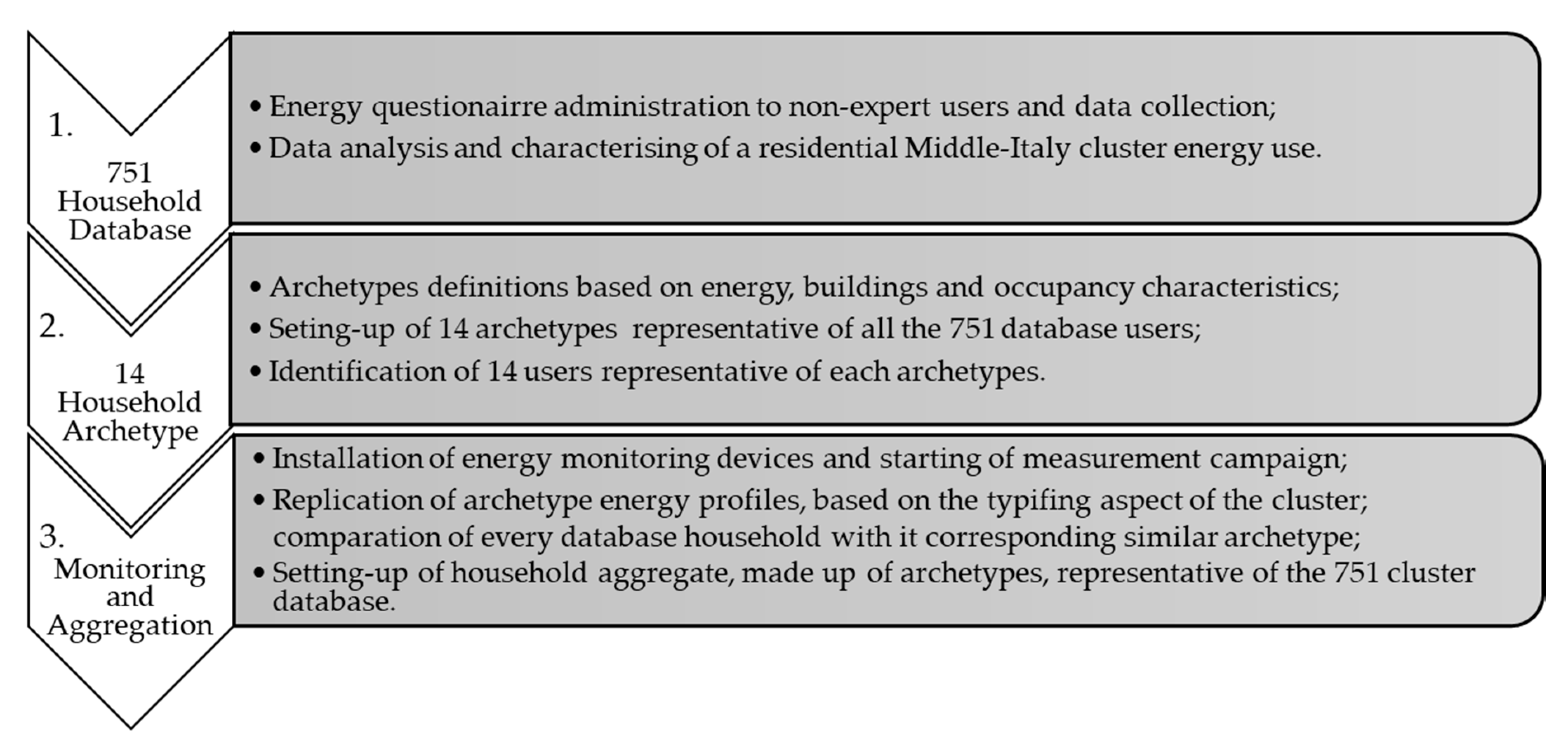
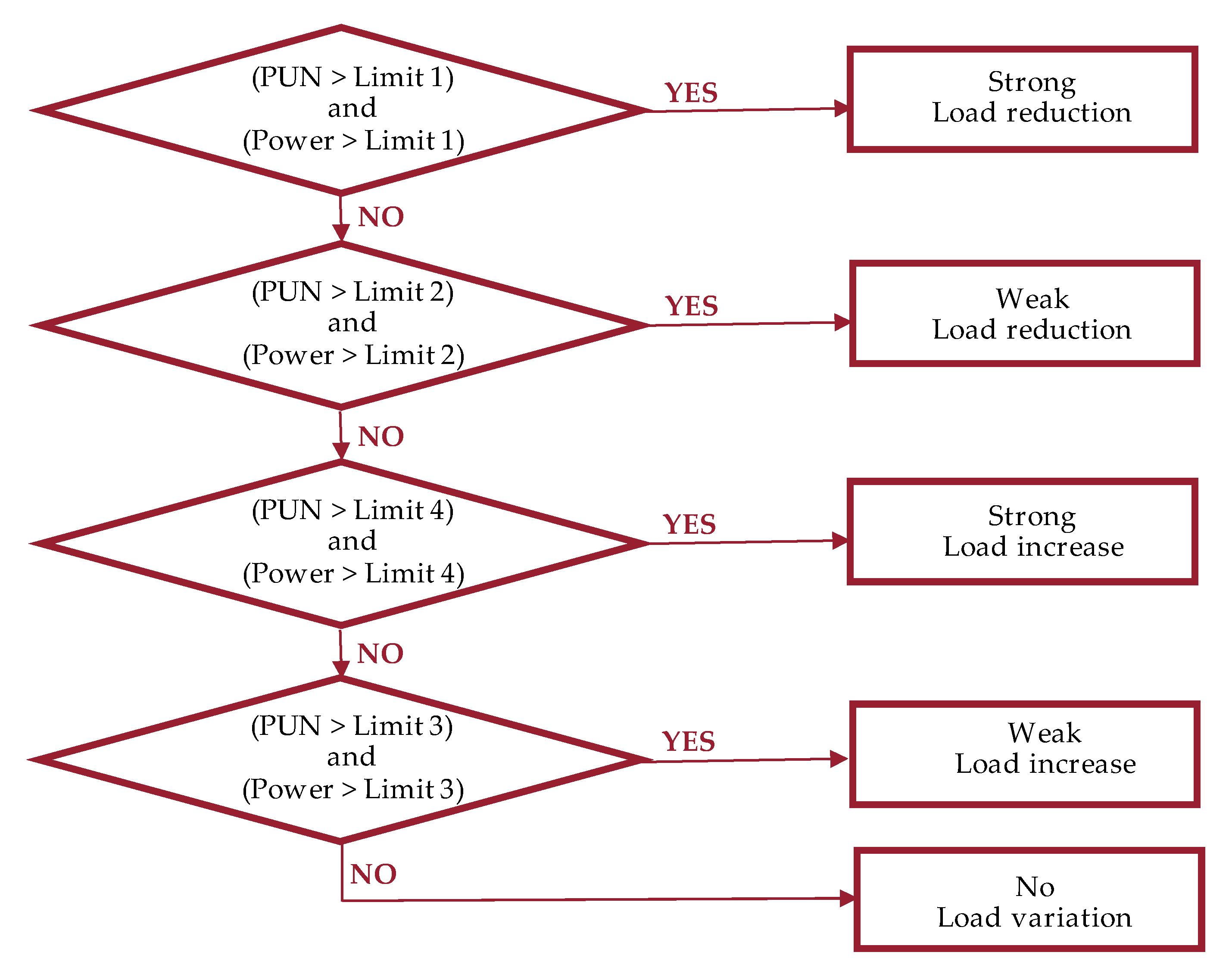

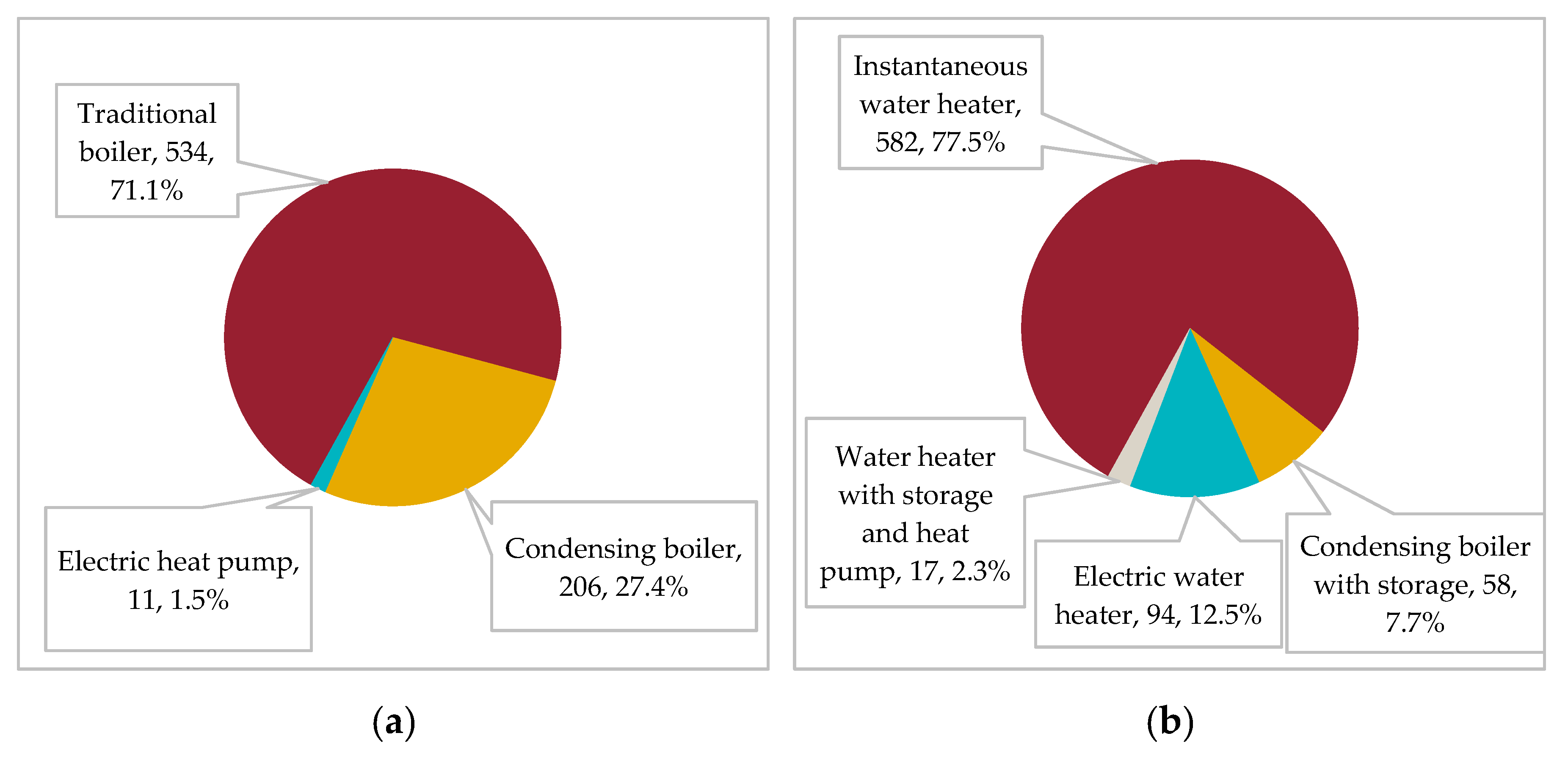
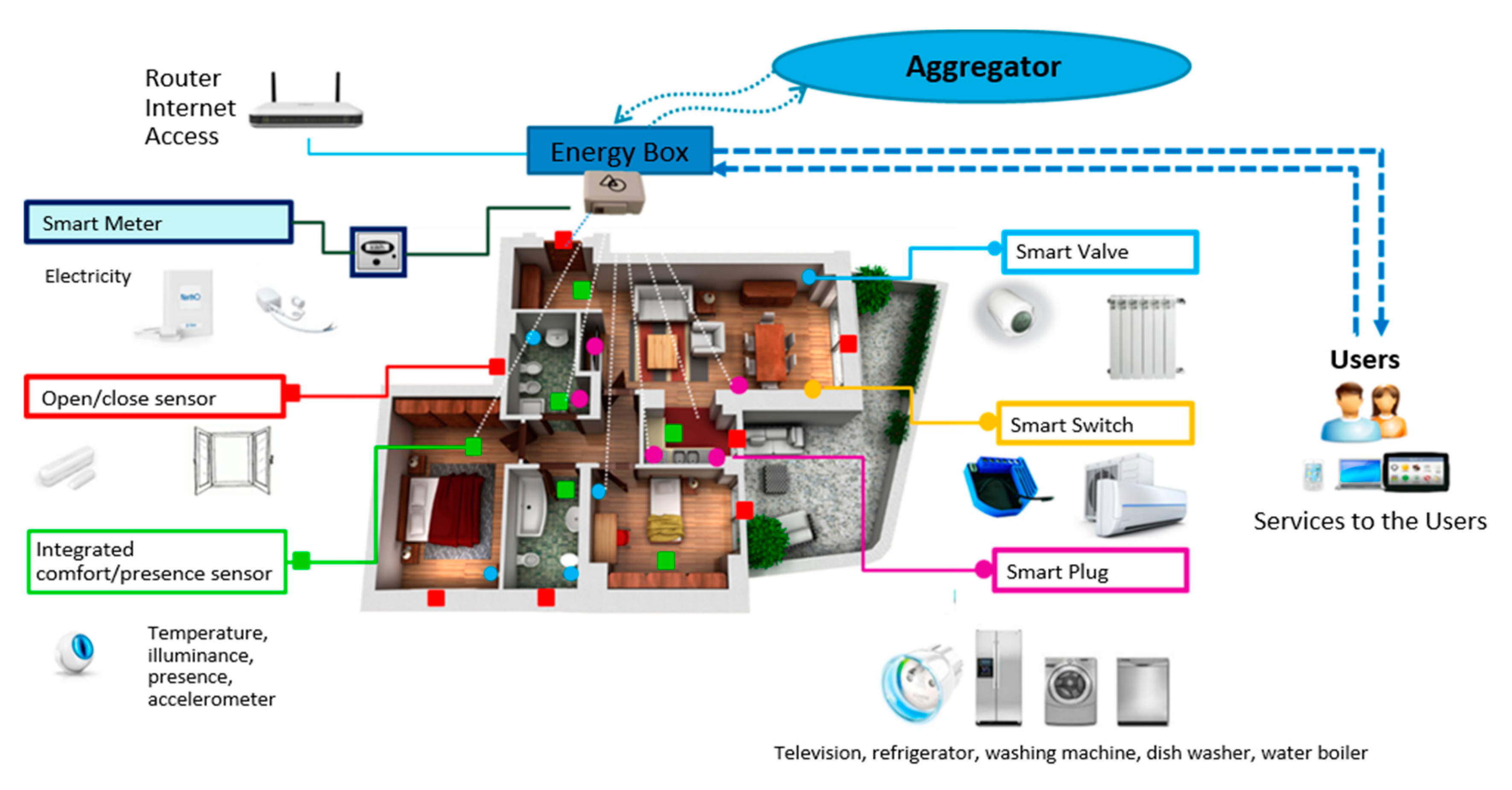
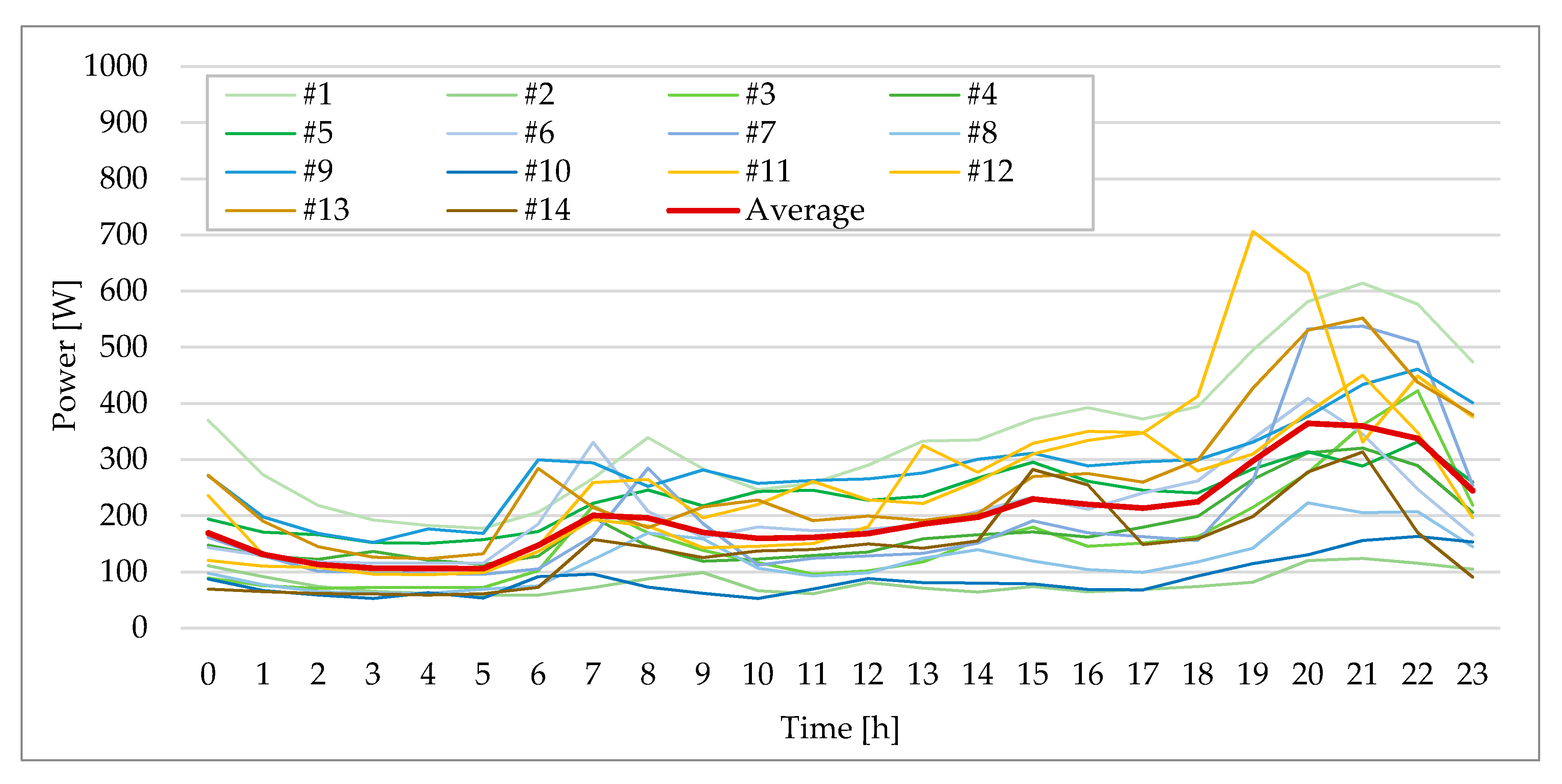
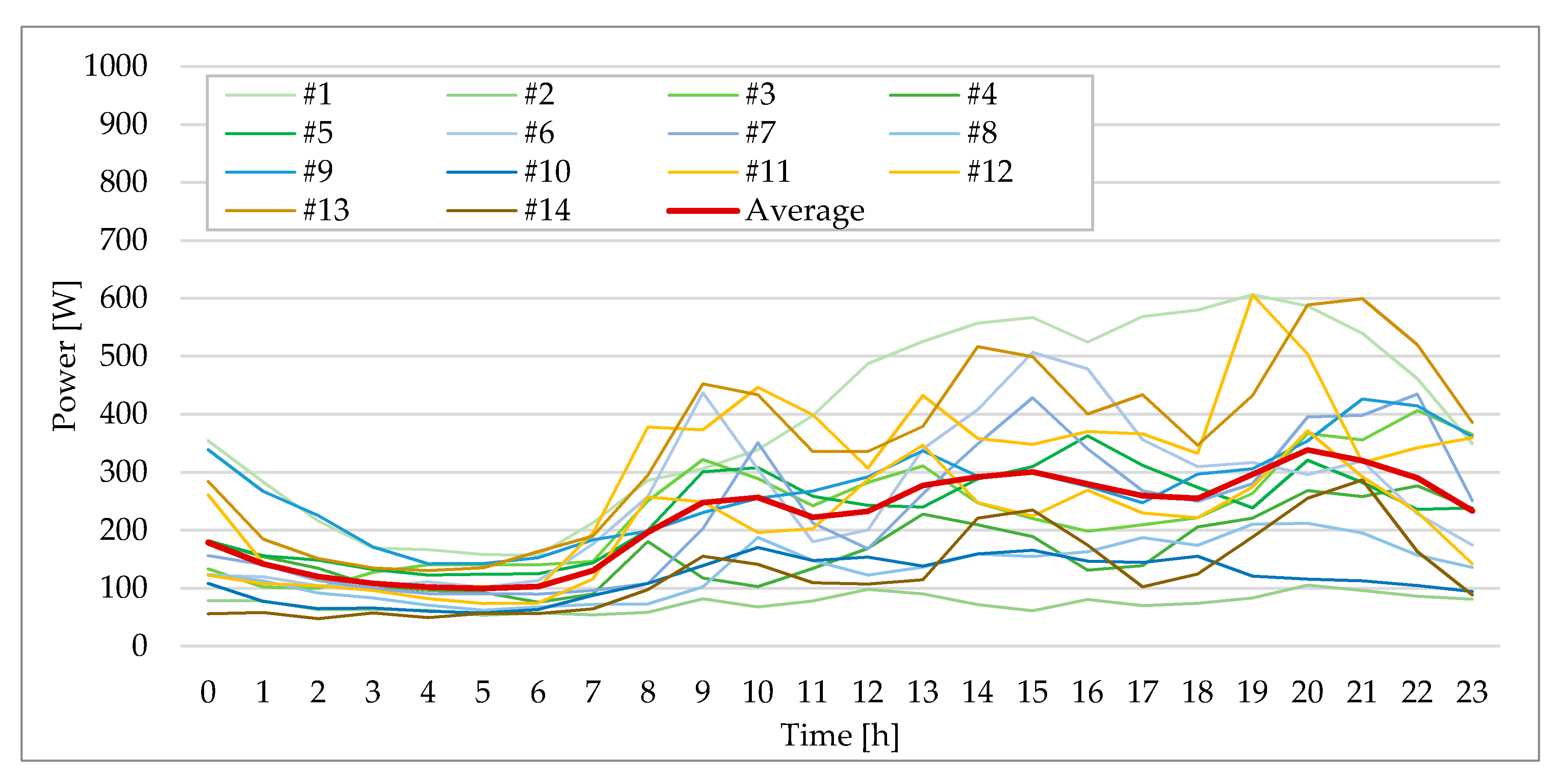
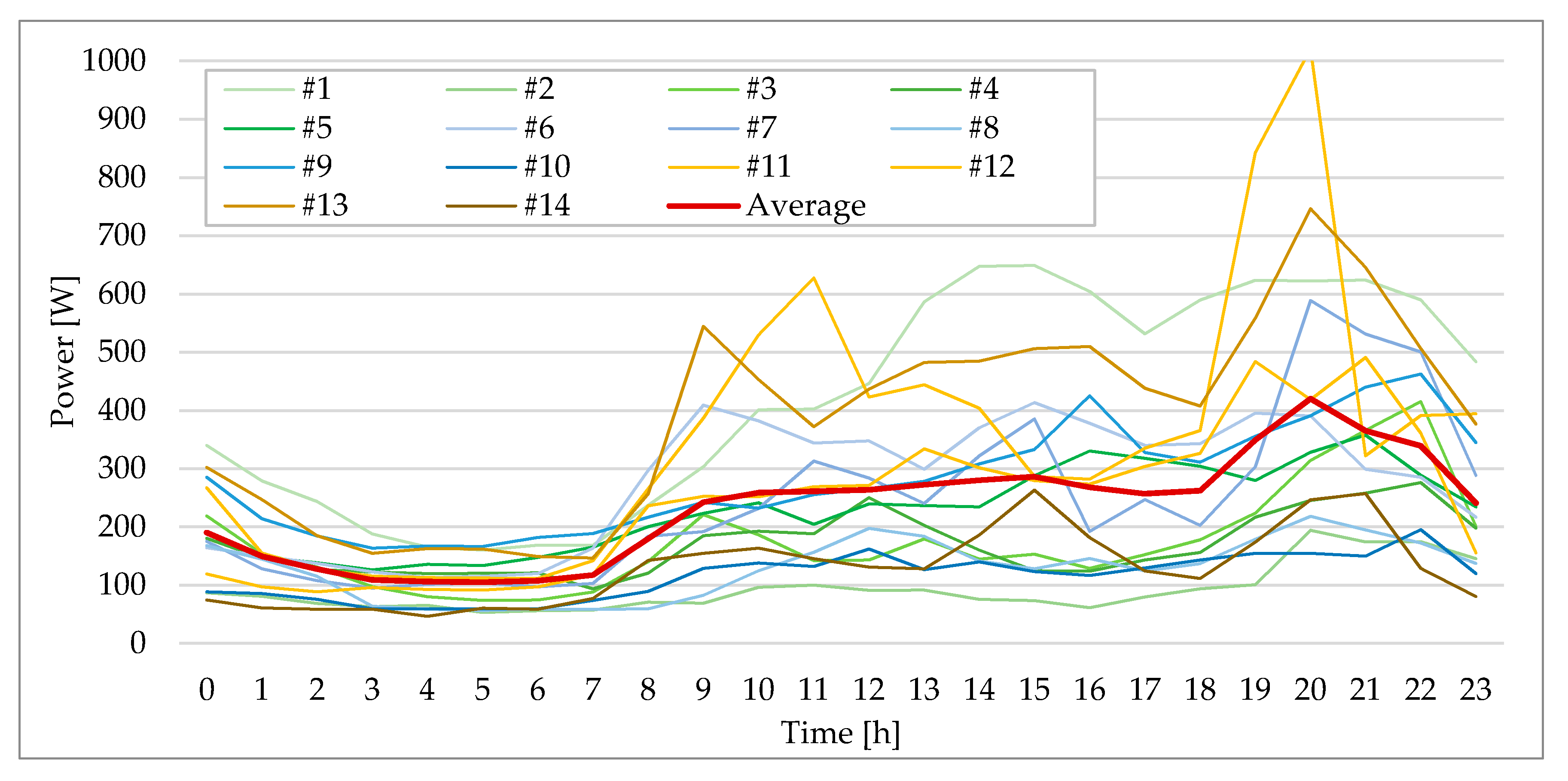
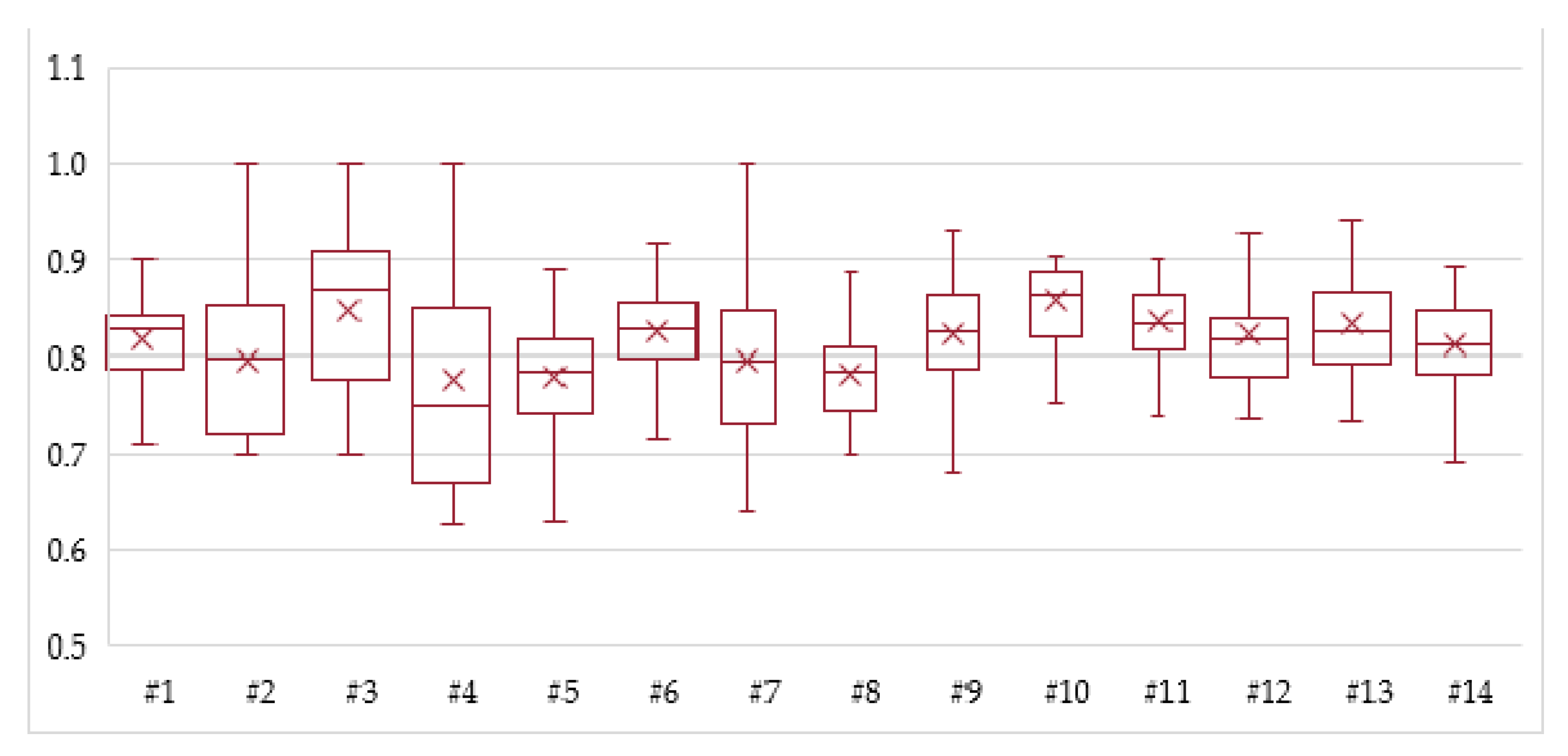
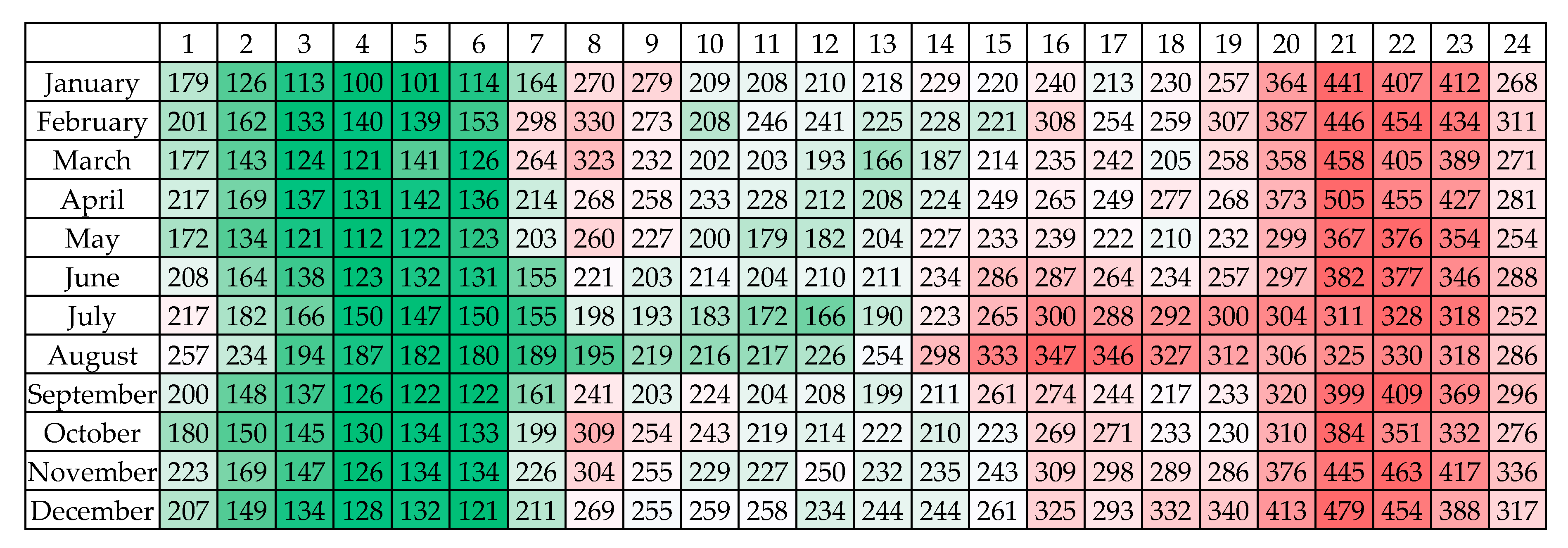










| Typifying Aspects (A) | Criterium | Max Grade * (Gmax) | Grade * |
|---|---|---|---|
| Storable Loads | Relative deviation | 0.15 | (A/Aref) * Gmax or (Aref/A) * Gmax |
| Deferrable Loads | Relative deviation | 0.15 | (A/Aref) * Gmax or (Aref/A) * Gmax |
| Non-deferrable Loads | Relative deviation | 0.15 | (A/Aref) * Gmax or (Aref/A) * Gmax |
| Heating or DHW ** | Energy carrier | 0.05 | Electricity = 0.05; NG ** = 0 |
| PV ** array | Installation/lack | 0.05 | Installed = 0.05; Missing = 0.00 |
| Dwelling floor surface | Relative deviation | 0.10 | (A/Aref) * Gmax or (Aref/A) * Gmax |
| Occupants Number | Relative deviation | 0.10 | (A/Aref) * Gmax or (Aref/A) * Gmax |
| Occupancy in time span 8–13 | presence/absence | 0.10 | Present = 0.10; Missing = 0.00 |
| Occupancy in time span 13–19 | presence/absence | 0.10 | Present = 0.10; Missing = 0.00 |
| Occupancy in time span 19–0 | presence/absence | 0.025 | Present = 0.025; Missing = 0.00 |
| Occupancy in time span 0–8 | presence/absence | 0.025 | Present = 0.025; Missing = 0.00 |
| TOTAL | 1.00 |
| Archetype | Floor Surface [m2] | Heating and DHW * | Cooling * | PV Array | WM ** | DW ** | TD ** |
|---|---|---|---|---|---|---|---|
| #1 | 49 | NCB | 2 HP | 7; 5; A+ | 6; 7; A | ||
| #2 | 101 | NCB | 1 HP | 10; 2.5; A | |||
| #3 | 100 | NCB | 1 HP | 7; 5; A+ | |||
| #4 | 50 | NCB | 1 HP | 7; 1.5; A+ | 5; 0.5; A | ||
| #5 | 100 | CB + HP | 4 HP | 7; 4; A++ | 5; 4; A | 5; 4; A | |
| #6 | 65 | CB | 3 HP | 7; 6; A | 12; 3.5; A | 7; 0.5; B | |
| #7 | 65 | NCB | 1 HP | 7; 5; A+ | 6; 7; A | ||
| #8 | 60 | CB | 7; 2; A++ | 12; 1.5; A+ | |||
| #9 | 95 | NCB | 2 HP | 7; 5; A+++ | 12; 8; A+ | ||
| #10 | 102 | NCB | 1 HP | 7; 3; A+ | 14; 5; A | ||
| #11 | 67 | CB | 10; 5; B | 6; 5; B | |||
| #12 | 134 | CB | 7; 6; A | 14; 7; A | 6; 3; B | ||
| #13 | 124 | CB | 5; 4; A | 12; 7; A+ | |||
| #14 | 123 | NCB + solar collectors | 3.9 kW | 5; 4; A | 12; 7; A+ |
| Archetype | Occupants * | Description |
|---|---|---|
| #1 | 4; (1; 3; 4; 4) | Family with two teenage children and one unemployed parent |
| #2 | 2; (0; 0; 2; 2) | Commuter Workers |
| #3 | 4; (0; 3; 4; 4) | Family with school-aged children, and one part-time working parent |
| #4 | 1; (0; 0; 1; 1) | Commuter Worker |
| #5 | 4; (1; 3; 4; 4) | Family with school-aged children, and one home parent |
| #6 | 4; (1; 3; 4; 4) | Family with school-aged children and babies, and one unemployed parent |
| #7 | 3; (0; 0; 3; 3) | Family with a baby and commuter parents |
| #8 | 2; (1; 1; 2; 2) | Commuter worker, awaiting employment |
| #9 | 3; (1; 2; 3; 3) | Family with a school-aged child, and one commuter worker |
| #10 | 2; (0; 1; 2; 2) | Family of commuter workers |
| #11 | 3; (0; 2; 3; 3) | Family with a school-aged child, and two commuter workers |
| #12 | 4; (0; 1; 4; 4) | Family with two adult children, two commuter parents |
| #13 | 2; (0; 1; 2; 2) | Family with a school-aged child, and two commuter workers |
| #14 | 2; (2; 2; 2; 2) | Two Pensioners |
| Function | Device | Archetype | |||||||||||||
|---|---|---|---|---|---|---|---|---|---|---|---|---|---|---|---|
| #1 | #2 | #3 | #4 | #5 | #6 | #7 | #8 | #9 | #10 | #11 | #12 | #13 | #14 | ||
| Energy box | Gateway | 1 | 1 | 1 | 1 | 1 | 1 | 1 | 1 | 1 | 1 | 1 | 1 | 1 | 1 |
| Monitoring | Electricity meters | 1 | 1 | 1 | 1 | 2 | 1 | 1 | 1 | 1 | 1 | 1 | 1 | 1 | 2 |
| Multi-sensors (temperature, presence, brightness) | 5 | 6 | 6 | 4 | 6 | 6 | 4 | 4 | 7 | 6 | 3 | 9 | 7 | 7 | |
| Windows/doors opening and closing detectors | 7 | 8 | 6 | 5 | 8 | 8 | 5 | 5 | 10 | 10 | 6 | 9 | 12 | 9 | |
| Control | Smart Valves | 6 | 5 | 0 | 4 | 3 | 6 | 5 | 3 | 8 | 6 | 0 | 0 | 7 | 0 |
| Smart Plugs | 4 | 3 | 4 | 4 | 3 | 4 | 4 | 3 | 3 | 4 | 3 | 5 | 3 | 6 | |
| Smart Switches | 1 | 0 | 0 | 0 | 1 | 1 | 1 | 1 | 1 | 1 | 0 | 1 | 0 | 0 | |
| Parameters | Archetype | |||||||||||||
|---|---|---|---|---|---|---|---|---|---|---|---|---|---|---|
| #1 | #2 | #3 | #4 | #5 | #6 | #7 | #8 | #9 | #10 | #11 | #12 | #13 | #14 | |
| Storable Loads [kWh] | 191 | 106 | 111 | 165 | 950 | 213 | 112 | 49 | 181 | 110 | 46 | 92 | 122 | 81 |
| Deferrable Loads [kWh] | 667 | 188 | 549 | 190 | 808 | 714 | 549 | 139 | 915 | 618 | 820 | 1274 | 835 | 556 |
| Non-deferrable Loads [kWh] | 2648 | 1024 | 1085 | 879 | 1298 | 1000 | 1099 | 881 | 2384 | 1218 | 1049 | 1754 | 1439 | 959 |
| DHW | 0 | 0 | 0 | 0 | 1 | 0 | 0 | 0 | 0 | 0 | 0 | 0 | 0 | 0 |
| PV array [-] | 0 | 0 | 0 | 0 | 0 | 0 | 0 | 0 | 0 | 0 | 0 | 0 | 0 | 1 |
| Dwelling Floor Surface [m2] | 49 | 101 | 66 | 50 | 100 | 50 | 66 | 60 | 94 | 102 | 67 | 134 | 137 | 110 |
| Occupants Number [-] | 4 | 2 | 3 | 1 | 4 | 4 | 2 | 2 | 3 | 2 | 3 | 4 | 3 | 2 |
| Occupancy in time span 8–13 | 1 | 0 | 0 | 0 | 1 | 1 | 0 | 1 | 1 | 0 | 0 | 0 | 0 | 1 |
| Occupancy in time span 13–19 | 1 | 1 | 1 | 0 | 1 | 1 | 0 | 1 | 1 | 1 | 1 | 1 | 1 | 1 |
| Occupancy in time span 19–0 | 1 | 1 | 1 | 1 | 1 | 1 | 1 | 1 | 1 | 1 | 1 | 1 | 1 | 1 |
| Occupancy in time span 0–8 | 1 | 1 | 1 | 1 | 1 | 1 | 1 | 1 | 1 | 1 | 1 | 1 | 1 | 1 |
| Archetype | Dwellings Number | Cumulative Surface [m2] | Occupants | Electric Consumptions [kWh/year] | Storable Loads [kWh/year] | Shiftable Loads [kWh/year] |
|---|---|---|---|---|---|---|
| #1 | 31 (4.1%) | 4782 (5.2%) | 130 (5.1%) | 95,963 (6.7%) | 5310 (1.6%) | 18,081 (8.4%) |
| #2 | 16 (2.1%) | 1213 (1.3%) | 36 (1.4%) | 94,444 (6.6%) | 5894 (1.8%) | 17,602 (8.2%) |
| #3 | 18 (2.3%) | 1575 (1.7%) | 54 (2.1%) | 95,718 (6.7%) | 10,267 (3.1%) | 17,113 (8%) |
| #4 | 14 (1.8%) | 945 (1.0%) | 18 (0.7%) | 91,964 (6.4%) | 7479 (2.2%) | 16,595 (7.7%) |
| #5 | 102 (13.5%) | 12,419 (13.7%) | 369 (14.5%) | 262,070 (18.3%) | 178,992 (54.8%) | 16,305 (7.6%) |
| #6 | 138 (18.3%) | 18,056 (19.9%) | 531 (20.9%) | 110,935 (7.7%) | 28,897 (8.8%) | 16,048 (7.5%) |
| #7 | 14 (1.8%) | 1186 (1.3%) | 31 (1.2%) | 83,364 (5.8%) | 2507 (0.7%) | 15,830 (7.4%) |
| #8 | 83 (11%) | 5409 (5.9%) | 194 (7.6%) | 100,642 (7.0%) | 21,062 (6.4%) | 15,467 (7.2%) |
| #9 | 165 (21.9%) | 23,820 (26.3%) | 630 (24.8%) | 108,939 (7.6%) | 32,710 (10%) | 14,186 (6.6%) |
| #10 | 16 (2.1%) | 1631 (1.8%) | 37 (1.4%) | 77,844 (5.4%) | 3320 (1.0%) | 13,760 (6.4%) |
| #11 | 22 (2.9%) | 1822 (2%) | 69 (2.7%) | 71,965 (5%) | 1142 (0.3%) | 13,468 (6.3%) |
| #12 | 33 (4.3%) | 4592 (5%) | 135 (5.3%) | 73,460 (5.1%) | 4563 (1.3%) | 12,892 (6%) |
| #13 | 32 (4.2%) | 4975 (5.5%) | 115 (4.5%) | 76,550 (5.3%) | 7890 (2.4%) | 12,813 (6%) |
| #14 | 67 (8.9%) | 7923 (8.7%) | 189 (7.4%) | 84,345 (5.9%) | 16,070 (4.9%) | 12,686 (5.9%) |
| Aggregate | 751 (100%) | 90,355 (100%) | 2538 (100%) | 1,428,203 (100%) | 326,103 (100%) | 212,846 (100%) |
© 2020 by the authors. Licensee MDPI, Basel, Switzerland. This article is an open access article distributed under the terms and conditions of the Creative Commons Attribution (CC BY) license (http://creativecommons.org/licenses/by/4.0/).
Share and Cite
Mancini, F.; Romano, S.; Lo Basso, G.; Cimaglia, J.; de Santoli, L. How the Italian Residential Sector Could Contribute to Load Flexibility in Demand Response Activities: A Methodology for Residential Clustering and Developing a Flexibility Strategy. Energies 2020, 13, 3359. https://doi.org/10.3390/en13133359
Mancini F, Romano S, Lo Basso G, Cimaglia J, de Santoli L. How the Italian Residential Sector Could Contribute to Load Flexibility in Demand Response Activities: A Methodology for Residential Clustering and Developing a Flexibility Strategy. Energies. 2020; 13(13):3359. https://doi.org/10.3390/en13133359
Chicago/Turabian StyleMancini, Francesco, Sabrina Romano, Gianluigi Lo Basso, Jacopo Cimaglia, and Livio de Santoli. 2020. "How the Italian Residential Sector Could Contribute to Load Flexibility in Demand Response Activities: A Methodology for Residential Clustering and Developing a Flexibility Strategy" Energies 13, no. 13: 3359. https://doi.org/10.3390/en13133359
APA StyleMancini, F., Romano, S., Lo Basso, G., Cimaglia, J., & de Santoli, L. (2020). How the Italian Residential Sector Could Contribute to Load Flexibility in Demand Response Activities: A Methodology for Residential Clustering and Developing a Flexibility Strategy. Energies, 13(13), 3359. https://doi.org/10.3390/en13133359








